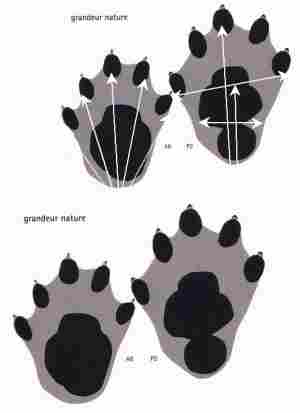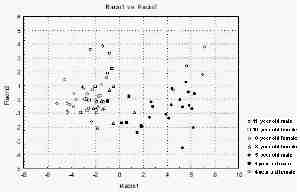 |
Last Update:
Thursday November 22, 2018
|
| [Home] |
|
Volume 21 Issue 2 Pages Pages 60 - 101 (January 2005) Citation: Mercier, L. & Fried, G. (2004) Preliminary Study of the Tracks of Captive Otters (Lutra lutra) as a Tool for Field Research. IUCN Otter Spec. Group Bull. 21(2): 94 - 99 Preliminary Study of the Tracks of Captive Otters (Lutra lutra) as a Tool for Field Research. Laurent Mercier1, Guillaume Fried 1 Otter Reintroduction Centre, Hunawihr, France. e-mail : loutremercier@hotmail.com (received 16th September 2004, accepted 16th October 2004)
INTRODUCTION Eurasian otter Lutra lutra tracks are relatively easy to identify for population surveys, but aspects of the tracks could also be used to identify characteristics of individual otters. Also, individual otter identity would help to determine population statistics such as numbers of individuals, sex, age ratios or size of territories. The major problem with tracking is the variation in print size depending on the degree of compression of the substratum, which is also function of the age and sex of otters. Moreover, weight of the otter, nature of the substratum, and moisture conditions affect the degree of compression whilst a young male may have similar sized tracks to an adult female. The objective of this preliminary study in captivity was to test the influence of three substratums on otter print size and try to develop a non-invasive field tracking technique to identify the sex, age and why not individual identity of otters. MATERIALS AND METHOD A study measuring 19 parameters of otter tracks on three substratums (snow, sand and limono-argileous mud) was conducted in summer 2003 at the Otter Reintroduction Centre, Hunawihr, France. The eight breeding enclosures at the centre allowed precise measurement of the tracks of nine individuals (five males and four females). Tubs containing the substratum material were dug into strategic sites used by the otters, such as along a fence or near a holt. The tubs were kept moist. One hundred and twenty-eight tracks were measured. Due to the significant differences observed, therefore, only data for back feet, measured on mud, were used in the present analysis as these data represented over half (69.2 %) of all back tracks monitored (Table 1). To check for differences between sexes and individuals, we used a discriminant analysis as described by BACKHAUS et al. (1996) and using STATISTICA software. For each individual analysis we obtained a classification function based on the formula: Y = b0 + b1X1 + b2X2 + … + biXi where "X1, X2, …, Xi" correspond to measurements of the print in the field and "b1, b2, … bi" are the discriminating coefficients. "b0" is a constant delivered by the software. RESULTS AND DISCUSSION Influence of substratum on track dimensions The discriminant analysis showed that dimensions were significantly different between substratums, particularly for 2 individuals (3 years old female: P=0,0012 < 0,05 & 5 years old male: P < 10-4 < 0,05). Unfortunately, lack of time and resources meant that it was not possible to prolong the test to obtain higher numbers of tracks for each substratum. It is planned, however, to repeat the test over a longer period, with the collaboration of other parks, to obtain more conclusive results. Despite the short duration of this preliminary study, there are some suggestions that care should be taken to note the substratum type when tracks are evaluated. DETERMINATION OF SEX FROM TRACK DIMENSIONS Otters like many mammals, exhibit sexual dimorphism so their tracks can be distinguished. The marked differences in body weights, when males are larger than females, have repercussions on the dimensions of tracks. The comparison of back tracks in mud of otters of known sex and ages, therefore, indicated that otters seem to exhibit sexual dimorphism and that the tracks of male and females could be distinguished with confidence (P = 5.11E-19 < 0.05). The discriminant analysis demonstrates and chooses seven of the 19 parameters, which are sufficient to distinguish males from females. The correct sex was tested through the discriminant analysis classification for 97,22% of prints. Thus, calculating and comparing the discriminant functions and coefficients for the tracks of back feet on a mud substratum distinguish males from females. Discriminant analysis of the various track measurements was used to provide a series of coefficients to assess the difference between male and female tracks (Table 2). Sex was attributed using the formula Y (sex coefficient) = (Ym (presumed male coefficient) - Yf (presumed female coefficient)). Both the presumed male and female coefficients were calculated by multiplying each of seven track measurements by the appropriate male and female coefficients (see Table 2); and the sex coefficient by subtracting the final presumed female value from the male. The print was attributed to a male when Y was positive and to a female when Y was negative, the higher the Y value is, the greater the confidence in the result. The following is given as an example of the comparison between two separate back tracks (where 'number*' = the compared measurement) : Y (Ym - Yf) = [(72.5*-10,2915888) + (55.83*1,78856003) + (32.17*-1,5458498) + (54.00*1,67097378) + (67.33*-1,23272276) + (72,67*15,5776567) + (56.00*1,52623034) - 317,205353] - [(72.5*-7,94367027) + (55.83*1,49818182) + (32.17*-1,19685888) + (54.00*1,34144676) + (67.33*-1,00010705) + (72,67*12,5073814) + (56.00*1,15367424) - 227,013809] = - 9,32724729 In this particular case, the print is attributed to a female as the final result is negative. Although the average lengths of male and female back feet were 89.4 mm and 73.3 mm, respectively, it must be remembered that the prints of young males and older females may be similar and it may be difficult to distinguish it through measurement. In this study, animals of suitable ages were not available in order to determine age limits for the successful application of this measurement technique. However, two young males of one year old, had tracks that were of approximately the same size as those of adult males (Total length = 82 mm) suggesting that the difference may be minimal. Individualization of otters from tracks HERTWECK et al. (1997) identified individual European otters from snow tracks using sophisticated equipment, such as a camera and expensive software. They demonstrated that fresh tracks in snow are the best samples to identify otters. The present study, using data from mud substratum only, showed that not all tracks could be used to identify individuals because only 91,67% of prints were correctly individualized. With the actual sample, Figure 2 shows the canonical distribution of each print on mud for the seven individuals. The diversity and the widespread of prints signify that it's not so easy to individualize tracks on mud; a margin of approximately 10% of error is possible.
CONCLUSION The aim of this preliminary study was to find a useful and non-invasive method for field researchers to identify Eurasian otter tracks. On one hand, the statistical tool, STATISTICA software, indicated that 7 of the original 19 parameters measured were sufficient to confidently identify the sex of the otter studied. On the other hand, individualization of otters from tracks in mud was inaccurate for more than 8% of it. Sample size may have been a limiting factor and this technique warrants further investigations. It is also suggested to otter parks to contribute to this study taking the seven principals measurements of prints for a bigger and more significative database. The collaboration could further develop the method and could finally allow obtaining more information on the wild population dynamic. REFERENCES Backhaus K., Erichson B., Plinke W. &
Weiber R. 1996. Multivariate Analysemethoden. Springer-Verlag. Heidelberg. Résumé : Etude préliminaire des empreintes de pas de la loutre d'Europe (Lutra lutra) en captivité, en vue d'une utilisation comme outil de recherche sur le terrain Resumen: |
| [Copyright © 2006 - 2050 IUCN/SSC OSG] | [Home] | [Contact Us] |

